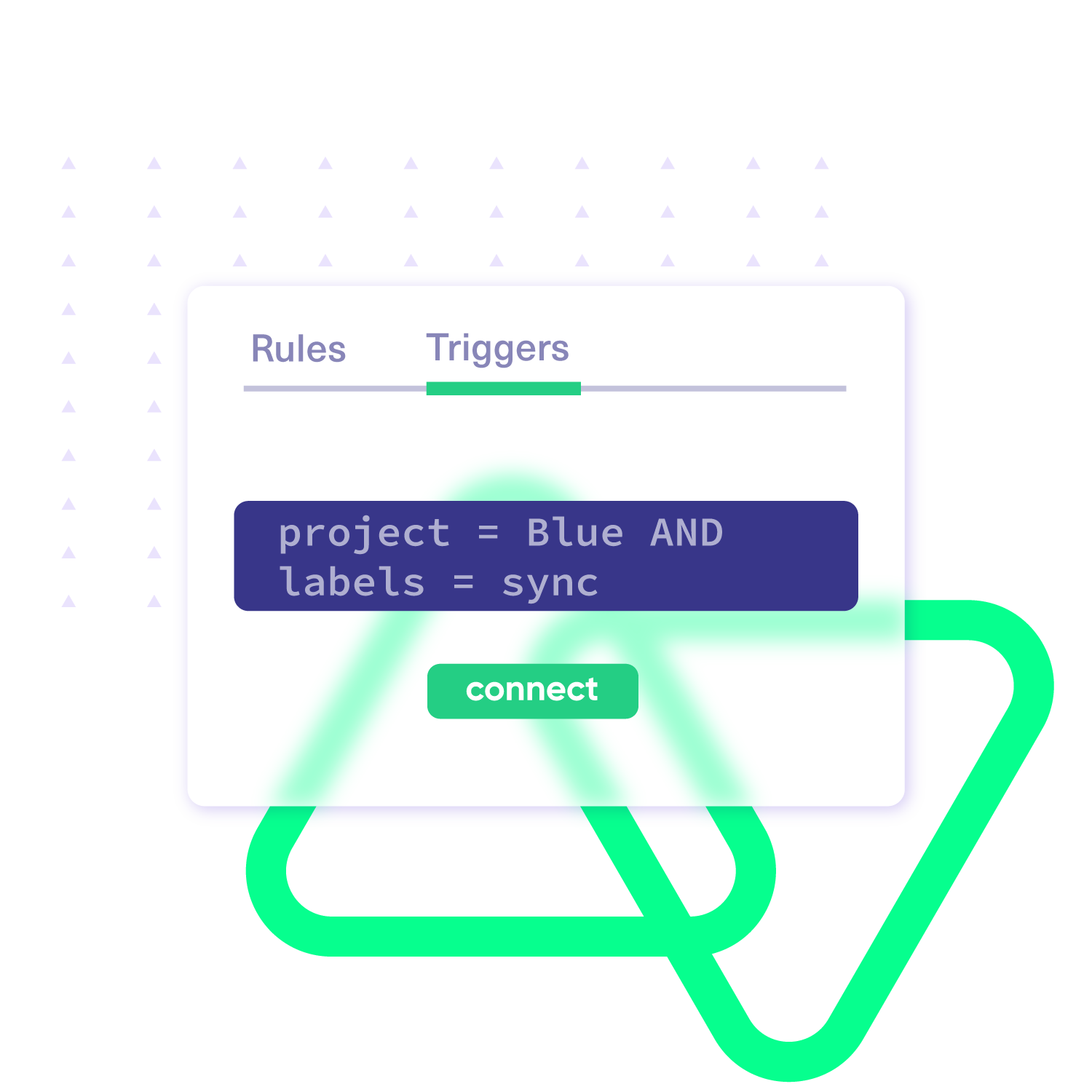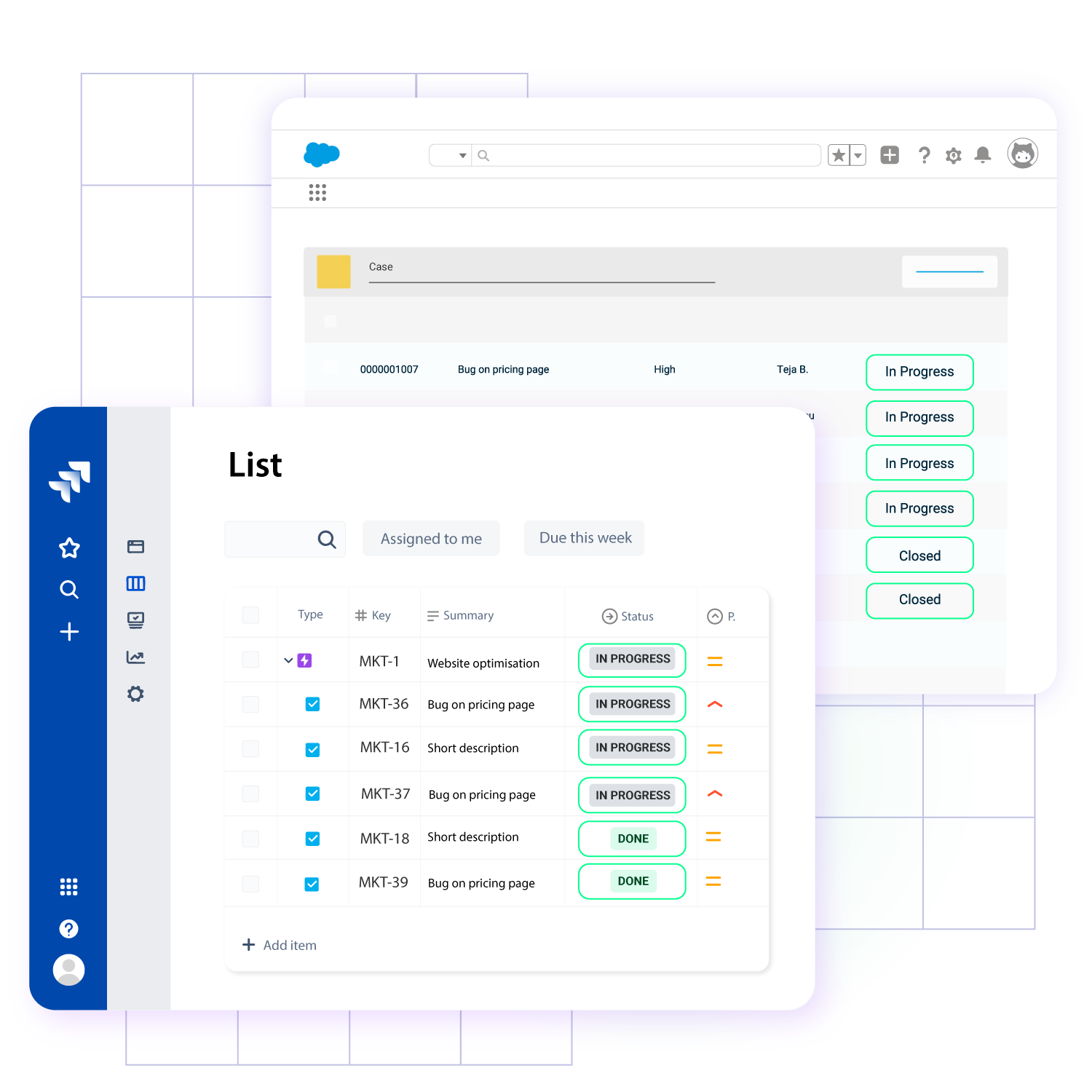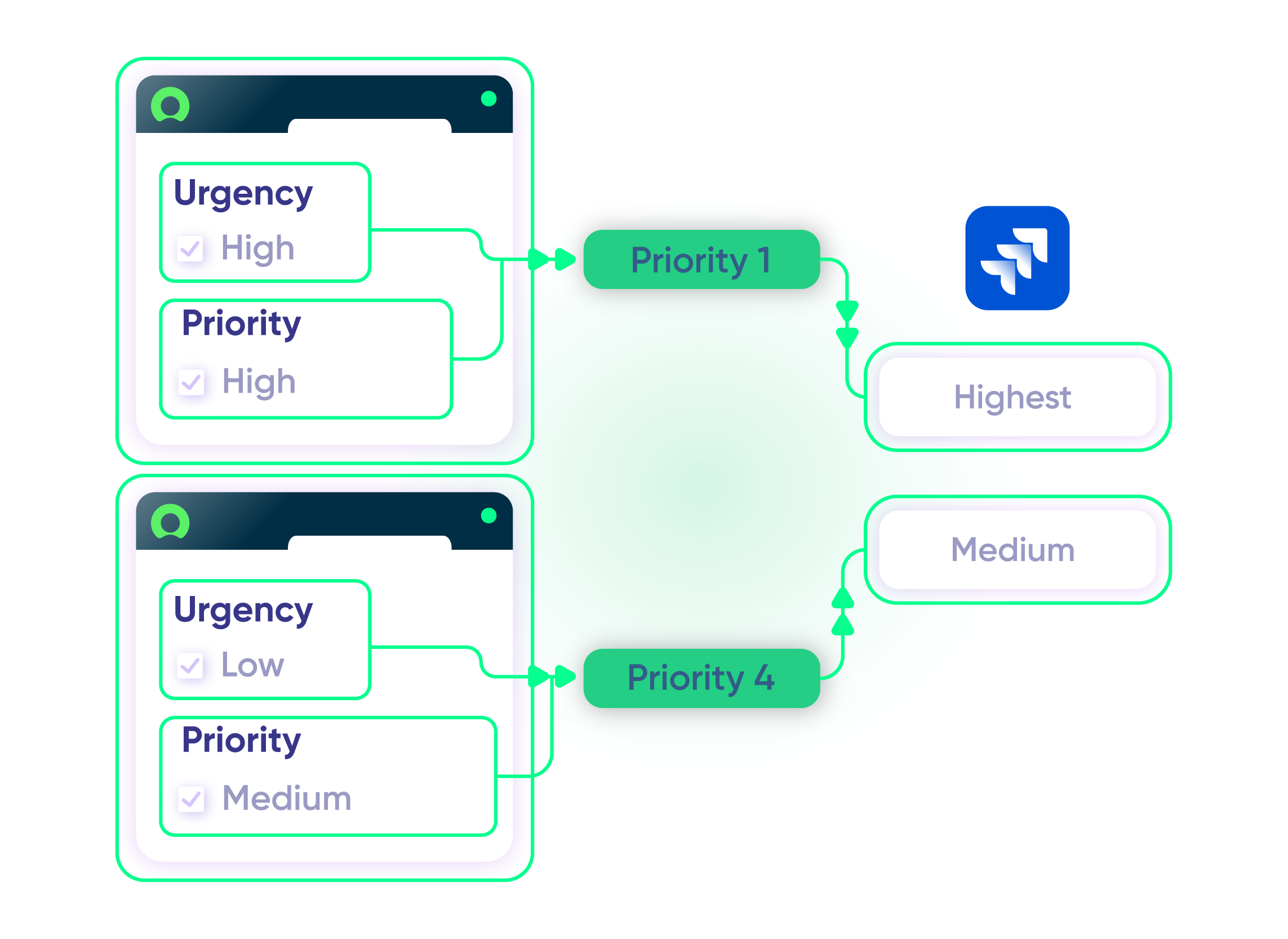flexible two-way sync
Jira ServiceNow Integration
Sync Jira issues and ServiceNow entities bi-directionally. Distribute your team’s collaboration across different systems, departments, and companies.
Integrate Jira and ServiceNow to share your data how you want and when you want.







Real-Time ServiceNow Jira Sync
Boost your team’s productivity by getting rid of context switching between Jira and ServiceNow
Real-time status updates on critical incidents and issues
Automatic syncs to save time and eliminate manual configuration errors
One-way and two-way syncs
Accurate and consistent reporting for the right stakeholders
Automatic sync restarts after downtimes and network interruptions
Automating critical business workflows end-to-end
Sync Exactly What Your Teams Need
Sync any entity using a one or two-way mapping. Configure and map the entities precisely as you require them.

Jira
Jira Software (Cloud and Data Center)
Jira Service Management
Work Items (Issues)
(Bugs, Tasks, Stories…)
+40 fields are supported, including:
- Custom fields
- Summary
- Status
- Description
- Key
- Comment
- Attachment
- Priority
- Third-party plugin fields (e.g Insights)
Sprints
All fields are supported, incuding:
- Name
- State
- Start date
- End date
- Complete goal
- Origin board ID
- Goal

ServiceNow
Incidents
All fields are supported, including:
- Custom fields
- Short description
- Description
- Assigned to
- Assignment group
- Priority
- Urgency
- State
- Work notes
Problems
All fields are supported, including:
- Problem statement
- Description
- Assigned to
- Priority
- Urgency
- Impact
- State
Change Requests
All fields are supported, incuding:
- Short description
- Description
- Assigned to
- State
- Type
- Impact
- Risk
- Requested by
Sync any Servicenow Entity
Sync all ServiceNow entities available via REST APIs.
Simply look for the field names in ServiceNow tables, choose what you want to sync, and add it to your script.
Check the full list of supported fields for Jira and for ServiceNow
“
Its hard to talk about supported fields, because with Exalate you can support a lot. And it is impossible to capture on a single page. We have done cases with very weird things - certainly not limited to the ones listed on the documentation.
Majid Hassan | Exalate Support Engineer
discover if we cover your integration requirements
Book a demo to see Exalate in action
Get the Most out of Your Jira ServiceNow Integration
Two-way Sync
Control the direction of data flow by choosing between one-way or two-way syncs.
Automated Integration
Eliminate the necessity for manual syncs by adding more granular controls. Automate your syncs with custom triggers powered by a native query language.
Bulk Operations
Use the custom Bulk Exalate feature to save time. Streamline workflows by connecting multiple existing entities with similar trigger configurations.
Custom Functions
Give your developers a chance to experiment with limitless syncing possibilities using the Groovy-based scripting engine. And yes, changes on one side won’t affect your setup at all.
AI-powered Integrations
Get instant technical help from our AI-powered documentation assistant Aida. Generate scripts faster with AI Assist, which is embedded in the Exalate UI.





Decentralized Integration
Maintain independent control over every sync, even for cross-company integrations. No need to share admin rights, no risk of exposing confidential information.
Better Scalability
Start small with out-of-the-box connections for basic synchronization scenarios. Scale up and grow faster with the help of script-based custom connections.
Top-notch Security
Get timely assistance from the best support technicians in the business. Pull up a chair as we help you solve every sync-related issue and more.
“
The fact that Exalate is a very extensible and flexible product is quite an impressive feature for us. We can even build our own integration on top of it, and it actually shows that the developers and the engineers behind the product do really know what they are doing. Plus we have had an excellent customer experience.
Alexander Sinno |

“
The fact that Exalate is a very extensible and flexible product is quite an impressive feature for us. We can even build our own integration on top of it, and it actually shows that the developers and the engineers behind the product do really know what they are doing. Plus we have had an excellent customer experience.
Alexander Sinno |

Set up, Customize, Sync!
01
install
Install the Exalate app on all the tools you want to sync.
02
connect
Connect the tools you want to integrate. Just add the instance’s URL.
03
customize
Configure your sync rules to make sure the right data is shared. Prompt the sync rules with AI-Assist or write your scripts from scratch.
04
automate
Set conditions with triggers, for an automatic synchronization.
05
synchronize
Now your instances are connected and will automatically exchange information instantly. Happy syncing!
See it in action
Simple or Advanced, We Got you Covered
Work with simple integration templates. Or, completely customize your sync.
Default Sync
Bi-directionally sync new and existing comments, descriptions, attachments, statuses, priorities, urgencies, work logs, and much more between Jira and ServiceNow. Use triggers to exert granular control over how the sync works.

Sync ServiceNow Change Request with Jira Issues
Keep customers informed about product changes in real time. Create change tasks for dedicated teams.
In practice:

...Or simply write a few lines of code
if(entityType == “changeRequest”) {
replica.summary = changeRequest.short_description replica.description = changeRequest.description replica.comments = changeRequest.comments replica.attachments = changeRequest.attachments
///other fields supported by the Change request entity

Sync Priority between ServiceNow and Jira
Maintain uniformity across all platforms. Give your ServiceNow entity the same level of priority or urgency as the Jira Issue.
In practice:

...Or simply write a few lines of code
. . .
def priorityMapping = [
“1 – Critical”: “High”,
“2 – High”: “High”,
“3 – Moderate”: “Medium”,
“4 – Low”: “Low”,
“5 – Planning”: “Lowest” ]
issue.priority = nodeHelper.getPriority(priorityName)

Store Correlation Details for Remote Entity
Use correlation fields to establish a relationship between local and remote systems. Store unique entity IDs, URLs, or other remote records in Jira and ServiceNow.
In practice:

...Or simply write a few lines of code
// retrieve the twin url from the incoming message
import groovy.json.JsonSlurper
def issueUrl = new JsonSlurper().parseText(syncRequest.replica.payload).get(“issueUrl”)
// setting the fields correlation_id and u_issue_key
entity.correlation_id = replica.key
entity.correlation_display = issueUrl

Sync Time-related Information
Convert incidents to epics that should be broken down into stories for easier time tracking. Keep an eye on time spent and resolution timelines.
In practice:

...Or simply write a few lines of code
def ced = new CollectEpicData(issue.key)
replica.customKeys.totalTimeSpent = ced.storyTotalTimeSpent
replica.customKeys.totalOriginalEstimate = ced.storyTotalOriginalEstimate
replica.customKeys.totalEstimate = ced.storyTotalRemainingEstimate

Sync Jira Service Management to ServiceNow
Connect multiple ServiceNow instances to a single Jira Service Management instance or vice versa.
In practice:
No need to code, simply add a trigger.

“
We can now handle around 500 customer incidents per week, thanks to Exalate, which is a very good result regarding the number of products we’re dealing with. It synchronizes 45x faster than our previous solution.
Christof Cuyper |

Priority Support
Get timely assistance from the best support technicians in the business. Pull up a chair as we help you solve every sync-related issue and more.

FAQ
Answers to the most frequent questions.
Didn't find what you were looking for? Ask Aida
You can sync custom fields, issues, comments, attachments, descriptions, attachments, and every other ServiceNow entity. To explore further sync possibilities, use the advanced scripting mode.
You can install Exalate for free to use the no-code Basic Mode for simple synchronization tasks. To get the advanced Script Mode, you need to buy the Premium Plan after a 30-day trial. Contact the sales team to get a more detailed pricing quote.
We offer Standard and Premier Support to our customers depending on their needs and the running service-level agreement. As part of our Premier Support, we’ll assign a dedicated support agent to assist with your problem. You’ll also get up-to-date progress reports about critical production issues.
Exalate has a built-in error recovery mechanism that allows you to fix problems and resume synchronization from the moment it fails. You can use the troubleshooter to examine the error stack trace to determine if the error occurred at the entity, connection, or application levels.
You can also choose to install Exalate on Jira via docker.
Access to these addons is via REST API requests, webhooks, iframes, etc depending on whether it’s Jira Cloud or on-premise.
Yes, Exalate supports single-tenancy, which minimizes the risk of information leakage at the infrastructure level. When a node is deployed on the Exalate Cloud, it runs inside a ‘Kubernetes pod’ configured to prevent information leaks.
Yes, you can use Exalate to connect multiple Jira and ServiceNow instances. Exlaate also supports other ITSM tools like Azure DevOps, Zendesk, Salesforce, and GitHub. Check out our integrations for more information.
Exalate protects the data flowing through your ServiceNow integration with Jira using security features such as JWT access tokens, role-based access controls, HTTP (HTTPs), TLS 1.2 and 1.3, and multi-factor authentication. It is also ISO 27001 certified. You can find out more from the security whitepaper.
How useful was this content?
Click on a star to rate it!
Average rating 4.9 / 5. Vote count: 223
No votes so far! Be the first to rate this post.
We are sorry that this post was not useful for you!
Let us improve this post!
Tell us how we can improve this post?


















